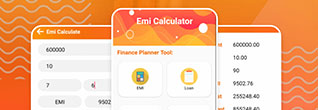

When people take a home loan for a property that is still being built, they often hear the term Pre-EMI. Many borrowers don’t fully understand how it’s calculated or how it affects the total cost of the loan. Knowing how to calculate Pre-EMI can help you plan your finances better and avoid paying extra interest.
Pre-EMI is the interest paid on the part of the loan that has been given to you. Unlike regular EMI, Pre-EMI only covers interest and doesn’t include any repayment of the loan amount. Borrowers pay this interest every month until the full loan is given, and the regular EMI payments start.
For example, if you take a home loan of ₹50 lakh but the bank releases ₹10 lakh in the first phase for construction, Pre-EMI is calculated only on ₹10 lakh. As more money is disbursed, the Pre-EMI amount increases accordingly.
Pre-EMI is calculated using the simple interest formula:
Interest = (Loan Amount × Interest Rate × Time) / 100
Since Pre-EMI is paid monthly, the formula is adjusted as:
Pre-EMI = (Loan Amount × Interest Rate × 1) / (12 × 100)
Where:
Loan Amount = The amount of loan disbursed
Interest Rate = The annual interest rate set by the bank
12 = Number of months in a year
Check the Loan Disbursed
Find out how much of your total loan has been disbursed by the bank. Banks disburse loans in stages for under-construction properties.
Find the Interest Rate
Banks provide home loans at different interest rates. Check your loan agreement or ask your bank for the exact interest rate.
Use the Formula
Multiply the loan amount by the annual interest rate.
Divide the result by 12 to get the monthly Pre-EMI amount.
Suppose you take a home loan of ₹40 lakh at an interest rate of 8% per annum. The bank releases ₹10 lakh in the first installment.
Pre-EMI for the first month = (10,00,000 × 8 × 1) / (12 × 100)
= (80,000) / 12
= ₹6,667 per month
If the bank releases another ₹10 lakh after 6 months, the Pre-EMI will be recalculated based on ₹20 lakh.
New Pre-EMI = (20,00,000 × 8 × 1) / (12 × 100)
= ₹13,334 per month
This process continues until the full loan is disbursed, after which regular EMI payments start.
Loan Disbursement Schedule
If the builder delays construction, the disbursement of the loan is also delayed, increasing the total Pre-EMI period.
Interest Rate Changes
If the bank increases the interest rate, your Pre-EMI amount will also increase. This usually happens in floating interest rate loans.
Loan Amount
The higher the loan amount disbursed, the higher the Pre-EMI.
Loan Tenure
The tenure of the loan does not directly affect Pre-EMI but plays a role in determining when full EMI starts.
Choose a Ready-to-Move Property
If possible, buy a ready-to-move-in property instead of an under-construction one to avoid paying Pre-EMI for a long time.
Make Larger Down Payment
Paying a higher down payment reduces the loan amount, which in turn reduces Pre-EMI and overall interest.
Opt for Full-EMI from the Beginning
Some banks allow borrowers to pay Full-EMI (principal + interest) from the start instead of Pre-EMI, which helps in reducing the loan burden faster.
Check the Builder’s Track Record
Builders who delay possession cause borrowers to pay Pre-EMI for a longer period. Choosing a reputed builder reduces this risk.
Prepay When Possible
If you get extra money, consider making a partial prepayment on your loan to reduce the Pre-EMI period.
Pre-EMI is an important part of home loans for properties that are still being built. It’s calculated based on the loan amount given to you and the interest rate. The longer the construction takes, the more Pre-EMI you will pay in total. Borrowers should plan their finances carefully and try to reduce Pre-EMI payments when they can. Choosing Full-EMI, making extra payments, or picking ready-to-move properties can help save money in the long run.
We understand that getting a loan can be very stressful with confusing documents, unclear communication, and various other challenges. That is why we take care of your loan application process, saving you time and hassle by handling the paperwork and communicating with the loan providers.
Check the details here at EazyBankLoan
Need help? Reach out at support@eazybankloan.com
Yes, some banks allow borrowers to start Full-EMI instead of Pre-EMI, even if the full loan amount is not disbursed.
No, Pre-EMI does not reduce the loan tenure because the principal amount is not repaid during this period.
No, Pre-EMI is mostly applicable to home loans for under-construction properties.
Pre-EMI lasts until the full loan amount is disbursed or the construction of the property is completed.
Pre-EMI reduces the initial financial burden but increases the overall loan cost due to extended interest payments.
No List Founds!
Your email address will not be published. Required fields are marked *
